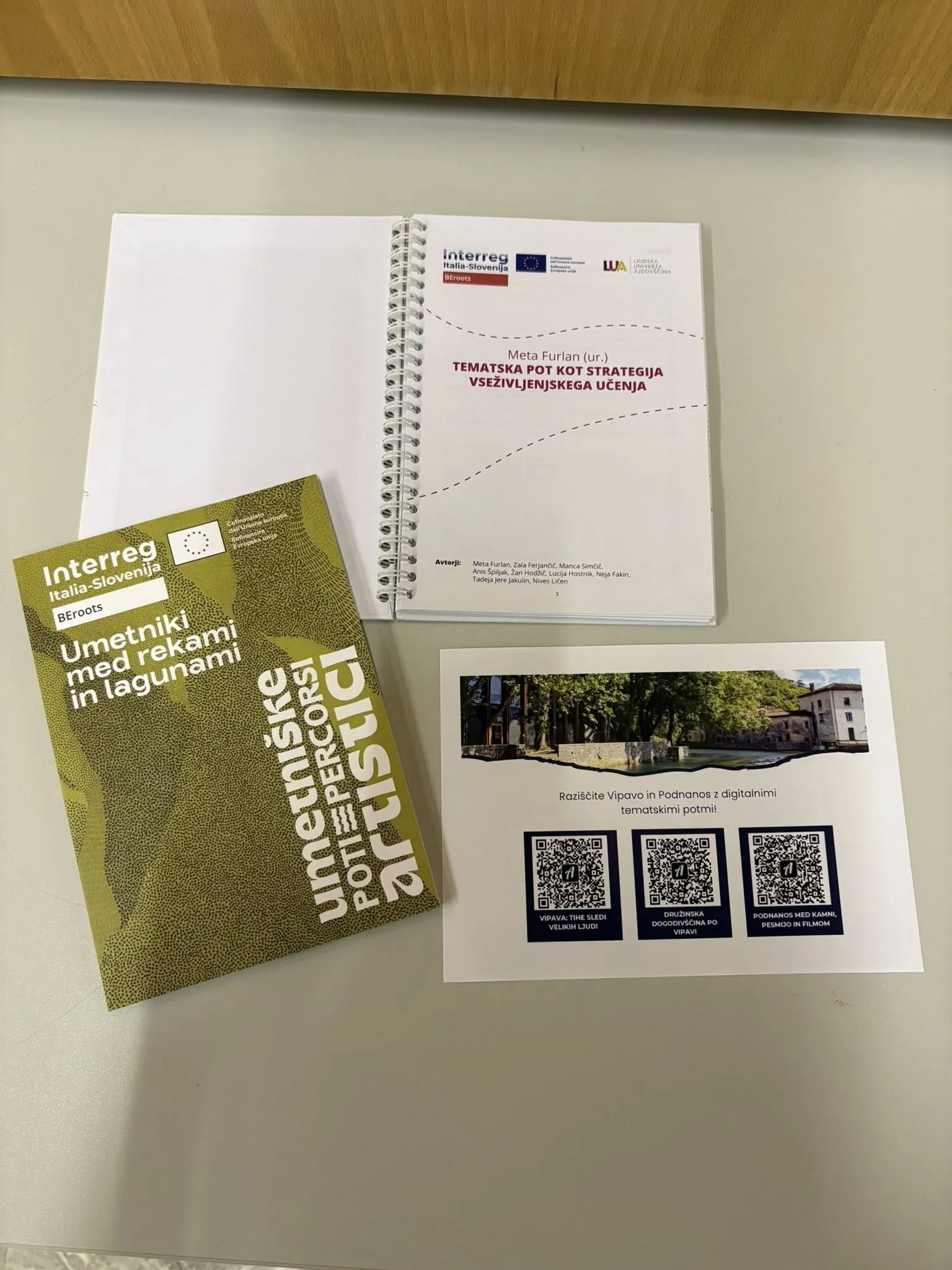Round Table: Traces of Art in the Cross-Border Area
On Wednesday, September 24, 2025, at 5:00 p.m., Ljudska univerza Ajdovščina, together with other BEroots project partners, organized a round table entitled Traces of Art in the Cross-Border Area: Undiscovered Authors between the Vipava and Soča Rivers at the France Bevk Public Library in Nova Gorica. The round table took place under the framework of the BEroots: Between Rivers and Lagoons – Artistic Routes project, co-financed by the European Union within the Interreg VI-A Italy–Slovenia programme.
In the first part of the round table, selected artists were presented, also featured in the brochure Artists: Between Rivers and Lagoons. The brochure collects life stories of painters, sculptors, poets, composers, and writers who marked the Vipava Valley, Sovodnje ob Soči, and the broader Venetian area. Many of these names remained in the shadow of more famous artists, yet in the brochure they were given voice and space.

Five speakers presented six artists. The discussion began with Dr. Urša Prša, who introduced Franjo Rojc, a folk poet. His life story was remarkable, as he was born in 1914, at the beginning of World War I. He was widely educated, with professional expertise in his field, and active in the economic—especially financial—sphere. He dedicated himself to local history, literature, and collecting national heritage, particularly local expressions from Sovodnje. He wrote poems devoted to local history, patriotic themes, and national identity issues.
Next, historian and professor Luca Vendrame presented Ippolito Nievo, author of one of the greatest modern Italian novels, Confessions of an Italian. His statement, “I was born a Venetian, I will die an Italian,” illustrates the Risorgimento movement (the unification of Italy). Through his work, in which the protagonist intertwines personal experience with historical events of the Risorgimento, he placed the borderlands between Veneto and Friuli among the immortal realms of Italian prose.
The following speaker, Jurij Rosa, presented the “Nightingale of Vipava,” Fran Žgur. His poems, born in the cultural ferment of his village, reflect love for his homeland, life’s milestones, religious holidays, folk customs, nature, and loved ones. He published two short selections of poems and a more extensive collection titled Pomladančki.
Marija Češčut introduced Peter Butkovič Domen. A man of many professions, he was a priest, poet, writer, translator, and riddle-maker. He was an organizer of cultural life, translating from 14 languages, and his works often carry autobiographical elements. Butkovič Domen is considered the father of Slovenian riddles and also a theorist of riddling.
From riddles, the discussion shifted to music and sound. Michele Lipani, deputy mayor of the Municipality of Portogruaro, presented Luigi Russolo, a man of diverse talents. He was a refined composer, painter, and inventor, one of the founders of the Futurist movement, and the author of the manifesto The Art of Noises, which makes him a pioneer of experimental music.
Finally, historian Jurij Rosa introduced Stanko Premrl, a priest and composer of a vast opus of Slovenian sacred music. He contributed to both sacred and secular music and was known as an exceptional organ virtuoso. He is most famous for composing the music to Prešeren’s Zdravljica, which became the Slovenian national anthem.

In the second part of the round table, Prof. Dr. Tadeja Jere Jakulin and Dr. Meta Furlan presented the scholarly monograph Thematic Trail as a Strategy of Lifelong Learning and three digital thematic trails designed for families, seniors, and schools. Thematic trails are more than just walks through cultural landscapes – they are a form of learning that combines movement, exploration, and experiencing heritage through art. As emphasized in the monograph, such trails foster curiosity, create opportunities for intergenerational exchange, and strengthen awareness that heritage is both part of our identity and a space for dialogue.
The digital trails developed within the BEroots project bring cultural content in a modern way. With the help of an app, participants can discover stories in the field, engage in tasks, and experience heritage actively through play and exploration. They are intended for families seeking shared experiences, seniors who wish to access heritage in an inclusive form, and schools, where teachers can integrate them as innovative learning tools.
The round table was moderated by Artur Lipovž, who skillfully connected guests and artists, words and songs, the past and the present.

The round table took place under the framework of the BEroots: Between Rivers and Lagoons – Artistic Routes project, co-financed by the European Union within the Interreg VI-A Italy–Slovenia programme. It was cofunded by the European Union. However, the views and opinions expressed are solely those of the author(s) and do not necessarily reflect those of the European Union. Neither the European Union nor the granting authority can be held responsible for them.
Meta Furlan is an employee of the Multigenerational Centre Goriška - VGC Goriška at the Ajdovščina Adult Education Centre, where she conducts programmes, information and socialactivities for vulnerable target groups and and organises events and other activities within the VGC Goriška.




